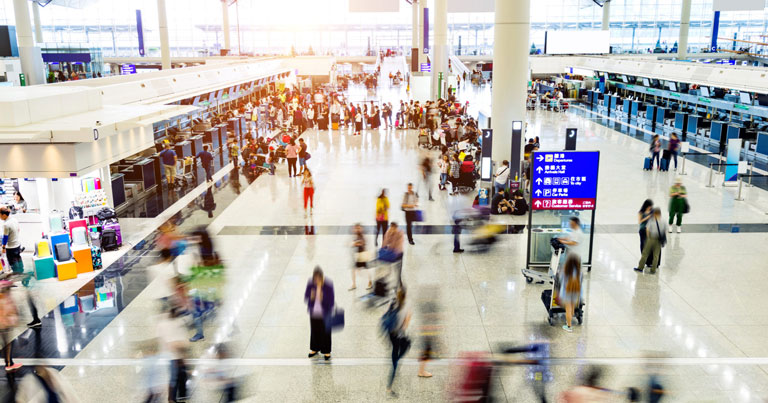
Airports Council International (ACI) World and the International Air Transport Association (IATA) have called on governments to ensure any new measures introduced for airports and airlines in the wake of COVID-19 are supported by scientific evidence and are consistent across the world.
ACI and IATA have jointly issued a paper laying out a pathway for restarting the aviation industry, titled ‘Safely Restarting Aviation – ACI and IATA Joint Approach’. Airlines and airports have cooperated to build a roadmap for resuming operations which reassures the travelling public that health and safety remain the overall priorities.
The joint statement proposes a layered approach of measures across the entire passenger journey to minimise the risk of transmission of COVID-19 at airports and onboard aircraft, and to prevent aviation becoming a meaningful source of international re-infection. ACI and IATA say that such measures should be globally consistent and subject to continued review, improvement, and removal when no longer required, to ensure an even recovery.
ACI and IATA are both central members the COVID-19 Aviation Recovery Task Force (CART) being led by the Council of the International Civil Aviation Organization (ICAO). CART enables the collaboration, among governments and between governments and industry, that is vital to ensure the harmonisation and consistency of measures that are essential to restoring air connectivity and passenger confidence in air travel.
ACI World Director General Angela Gittens commented: “Airports and airlines have come together with ICAO and the wider aviation industry to address the biggest challenge ever faced by commercial aviation in restarting a global industry while continuing to halt the spread of COVID-19. There is currently no single measure that could mitigate all the risks of restarting air travel but we believe a globally-consistent, outcome-based approach represents the most effective way of balancing risk mitigation with the need to unlock economies and to enable travel.”
IATA’s Director General and CEO Alexandre de Juniac added: “Safety is always our top priority and that includes public health. Restoring air connectivity is vital to restarting the global economy and reconnecting people. Our layered approach of measures recommended by airports and airlines safeguard public health while offering a practical approach for a gradual restart of operations. It is important to remember that the risk of transmission on board is very low. And we are determined that aviation will not be a significant source of re-infection. We are working continuously with governments to ensure that any measures put in place are done so consistently and with scientific backing. That is key to restoring public confidence so the benefits of safely re-starting aviation can be realised.”
IATA’s vision for restarting the aviation industry
Moreover, in a separate report, titled ‘Biosecurity for Air Transport: A Roadmap for Restarting Aviation’, IATA has proposed a layering of temporary biosecurity measures.
Pre-flight, IATA foresees the need for governments to collect passenger data in advance of travel, including health information, which should be accomplished using well-tested channels such as those used for eVisa or electronic travel authorisation programmes.
At the departure airport, IATA foresees several layers of protective measures:
- Access to the terminal building should be restricted to airport/airline workers and travellers (with exceptions being made for those accompanying passengers with disabilities or unaccompanied minors)
- Temperature screening by trained government staff at entry points to the terminal building
- Physical distancing through all passenger processes, including queue management
- Use of face coverings for passengers and masks for staff in line with local regulations
- Self-service options for check-in used by passengers as much as possible to reduce contact points and queues. This includes remote check-in (electronic / home printed boarding passes), automated bag drops (with home printed bag tags) and self-boarding
- Boarding should be made as efficient as possible with re-designed gate areas, congestion-reducing boarding priorities, and hand luggage limitations
- Cleaning and sanitisation of high touch areas in line with local regulations. This includes wide availability of hand sanitisers
In-flight, IATA foresees several layers of protective measures, including:
- Face coverings required for all passengers and non-surgical masks for crew
- Simplified cabin service and pre-packaged catering to reduce interaction between passengers and crew
- Reduced congregation of passengers in the cabin, for example by prohibiting queues for washrooms.
- Enhanced and more frequent deep cleaning of the cabin
At the arrival airport, IATA foresees several layers of protective measures, including:
- Temperature screening by trained government staff if required by authorities
- Automated procedures for customs and border control including use of mobile applications and biometric technologies (which have already proven tack record by some governments)
- Accelerated processing and baggage reclaim to enable social distancing by reducing congestion and queuing
- Health declarations and robust contact tracing are expected to be undertaken by governments to reduce the risk of imported chains of transmission






